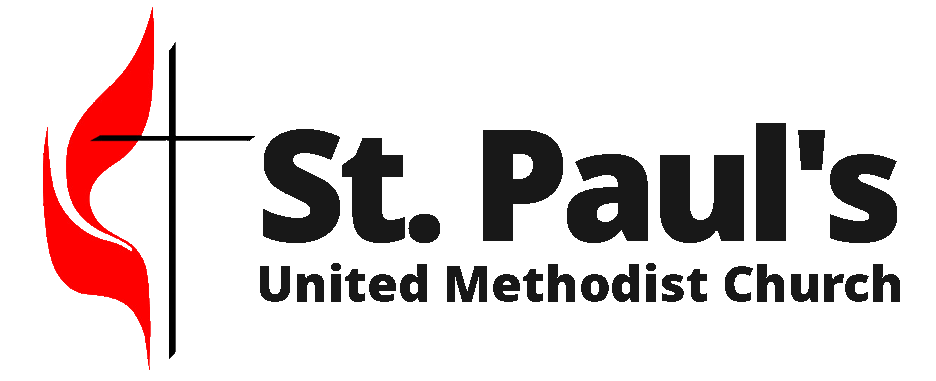St. Paul’s Story
Our church’s history dates back to 1836. This was at the time of Circuit Riders and Methodist Societies meeting in homes. Ours was the first Methodist church organized within the then boundaries of Toledo. Monroe Street and Collingwood Churches were organized somewhat earlier, but were outside the city limits.
After meeting in homes for a time, the Society purchased property on Huron Street between Walnut and Locust Streets for $100 and built a small frame meeting house. It is the one at the top on the cover of our bulletin today. By 1850 the congregation had grown to seventy members and felt they needed larger facilities and a better location. They bought a lot at the corner of Madison and Superior for $700. This is where Keybank is located now. A square brick building was built here for about $3,000.
The membership continued to grow and by 1865 they again needed larger facilities. They tore down the church and built a much larger and imposing one at a cost of about $65,000. There was a beautiful sanctuary on the second floor with Sunday School and social rooms beneath. It was a long struggle in both instances to pay for the buildings.
The congregation worshipped in this church for thirty some years. By the 1890’s the church was in the middle of the business section of the city and it was decided to change location again. The property at Madison and Superior was sold for $60,000 with the condition that the church could occupy it until the new church was completed. In 1913 this same property was sold for $300,000.
The new location was “way out” at Madison and 13th Street. The church was built of native limestone from the Welfare Farm at Whitehouse at a cost of $85,000.
The organ and windows from the second floor of the former church were moved to the new one. The cornerstone was laid in 1897.
The congregation voted in 1951 to remain in the inner city rather than move to the suburbs.
In January 1979 the church was entered in the U. S. Department of Interior’s National Register of Historic Places. The congregation worshipped at this location for over eighty years – until fire swept through on December 4, 1979, leaving not much more than the walls. The congregation rallied and decided to continue its ministry together.
The YMCA offered space to carry on immediately. Later the congregation moved to the Carriage House on 22nd Street for a time. From 1981 to 1987 Collingwood Presbyterian Church rented us their chapel and adjacent rooms. During this period over $600,000 was given to outreach programs from the interest of the insurance money.
In 1985 a half block at Madison and Twelfth Street with three buildings on it was purchased for $330,000 to build a new church. The Community Center, Shelter and Health Clinic were housed in the existing buildings. We gave $180,000 for the renovation of the Shelter.
The new church, where we are now, was built at a cost of over a million dollars, using the insurance proceeds. It was built to be barrier free, more maintenance free and fire proof. The first service was held here August 23, 1987.
St. Paul’s has been a leader in many new programs over the years. Among them are: the Golden Youth Club, the first Senior Citizen Club in Toledo, organized by Ed Brandeberry who is with us today.
The Character Research Project was a Sunday School program based on the Beatitudes and had close communication between the teachers and the parents.
The Life Enrichment Clinic helped people prepare for retirement.
The Thrift Shop helped fund a parish visitor. Interracial Hymn Sings, Fair Housing, Tutoring programs for children and adults. The first distribution center for Feed Your Neighbor.
After school recreation programs for children. After the schools began their after-school programs, the focus was turned to adults in the neighborhood. It began as a drop-in center for lonely adults. It expanded and St. Paul’s Community Center was born.
It provides meals, counseling, assistance in finding housing, handling finances, ongoing care and support for the physical and emotional well-being for the indigent and homeless. The Shelter provides temporary residential care for thirty persons.
The Mildred Bayer Health Clinic provides medical, dental and eye care by volunteers for the homeless.
The Winter Crisis opened the church to the homeless on cold winter nights. The Hillcrest Christian Center provided space for agencies dealing with problems of the indigent and homeless.
This came to a sudden halt with the fire of May 8, 1994. The One Step Up program has carried on since that fire. It provides help and support to single mothers and others. The Thursday luncheons help fund this.
“St. Paul’s has received a rich heritage from the love and labor of those who have worshipped here in the past. With this inheritance, we received, also a responsibility and an obligation to the future. The best we can do, all we can do, is to continue to build for the Kingdom here ‘where cross the crowded ways of life’.”
